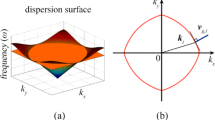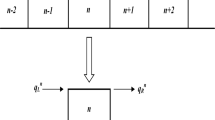Abstract
Dispersion engineering is always the important topic in the field of artificial periodic structures. In particular, topology optimization of composite structures with expected bandgaps plays a key role. However, most reported studies focused on topology optimization for bulk waves, and the optimization for surface wave bandgaps (SWBGs) is still missing. In this paper, we develop a topology optimization framework based on the genetic algorithm and finite element method to design periodic barriers embedded in semi-infinite space for reducing surface waves on demand. The objective functions for SWBGs are proposed based on the energy distribution properties of surface waves. The numerical results show that the optimization framework has stable convergence for this problem and is effective to optimize SWBGs. Considering large SWBGs and low filling fraction of solids, we investigate single- and multi-objective optimizations, respectively, and obtain novel wave barriers with good performance. The beneficial configuration features and mechanism of broadband SWBGs from the optimized results are explored. The results indicate that for the first-order SWBG, most optimized structures consist of a main scatterer at the center and some subsidiary scatterers near the surface. The rigid body resonance of the main scatterer determines the lower edge of SWBG, and the subsidiary scatterers can regulate the upper edge. Higher-order SWBGs are generated from the interaction of multiple scatterers, whose relative distance has a great influence on the position of SWBGs. The optimized structures can make the surface waves propagate far away from the surface within the frequencies of bandgaps, leading to a strong attenuation of surface vibration. In practice, our topological optimization framework is promising in designing high-performance surface wave devices and novel isolating structures for earthquake or environmental vibration in civil engineering.















Similar content being viewed by others

Data availability statement
All data used during the study are available from the corresponding author by request.
References
Achenbach J (1973) Wave propagation in elastic solids. North Holland, Amsterdam
Bilal OR, Hussein MI (2011) Ultrawide phononic band gap for combined in-plane and out-of-plane waves. Phys Rev E 84:65701
Chen Y, Guo D, Li YF, Li G, Huang X (2019) Maximizing wave attenuation in viscoelastic phononic crystals by topology optimization. Ultrasonics 94:419–429
Deb K, Pratap A, Agarwal S, Meyarivan T (2002) A fast and elitist multiobjective genetic algorithm: NSGA-II. IEEE Trans Evol Comput 6(2):182–197
Dolatshahi KM, Rezaie A, Rafiee-Dehkharghani R (2020) Topology optimization of wave barriers for mitigation of vertical component of seismic ground motions. J Earthq Eng 24(1):84–108
Dong HW, Su XX, Wang YS (2014a) Multi-objective optimization of two-dimensional porous phononic crystals. J Phys D Appl Phys 47(15):155301
Dong HW, Su XX, Wang YS, Zhang C (2014b) Topology optimization of two-dimensional asymmetrical phononic crystals. Phys Lett A 378(4):434–441
Dong HW, Su XX, Wang YS, Zhang C (2014c) Topological optimization of two-dimensional phononic crystals based on the finite element method and genetic algorithm. Struct Multidiscip Optim 50(4):593–604
Dong HW, Wang YS, Wang YF, Zhang C (2015) Reducing symmetry in topology optimization of two-dimensional porous phononic crystals. AIP Adv 5(11):117149
Dong HW, Zhao SD, Wang YS, Zhang C (2017) Topology optimization of anisotropic broadband double-negative elastic metamaterials. J Mech Phys Solids 105:54–80
Dong HW, Zhao SD, Wei P, Cheng L, Wang YS, Zhang C (2019) Systematic design and realization of double-negative acoustic metamaterials by topology optimization. Acta Mater 172:102–120
Du Q, Zeng Y, Xu Y, Yang H, Zeng Z (2018) H-fractal seismic metamaterial with broadband low-frequency bandgaps. J Phys D Appl Phys 51(10):105104
Gazonas GA, Weile DS, Wildman R, Mohan A (2006) Genetic algorithm optimization of phononic bandgap structures. Int J Solids Struct 43(18–19):5851–5866
Goo S, Kook J, Wang S (2020) Topology optimization of vibroacoustic problems using the hybrid finite element–wave based method. Comput Method Appl M 364:112932
Guo X, Zhang W, Zhong W (2014) Doing topology optimization explicitly and geometrically—a new moving morphable components based framework. J Appl Mech 81(85):081009
Halkjær S, Sigmund O, Jensen JS (2005) Inverse design of phononic crystals by topology optimization. Zeitschrift für Krist Mater 220(9–10):895–905
Halkjær S, Sigmund O, Jensen JS (2006) Maximizing band gaps in plate structures. Struct Multidiscip Optim 32(4):263–275
Hedayatrasa S, Abhary K, Uddin M, Ng C-T (2016a) Optimum design of phononic crystal perforated plate structures for widest bandgap of fundamental guided wave modes and maximized in-plane stiffness. J Mech Phys Solids 89:31–58
Hedayatrasa S, Abhary K, Uddin MS, Guest JK (2016b) Optimal design of tunable phononic bandgap plates under equibiaxial stretch. Smart Mater Struct 25:55025
Holland JH (1975) Adaptation in natural and artificial systems. University of Michigan Press, Ann Arbor
Hussein MI, Hamza K, Hulbert GM, Saitou K (2007) Optimal synthesis of 2D phononic crystals for broadband frequency isolation. Waves Random Complex Media 17(4):491–510
Imani M, Ghoreishi SF (2020) Bayesian optimization objective-based experimental design. In Proceedings of the 2020 American Control Conference (ACC 2020) IEEE
Imani M, Dougherty ER, Braga-Neto U (2020) Boolean Kalman filter and smoother under model uncertainty. Automatica 111:108609
Kushwaha MS, Halevi P, Dobrzynski L, Djafari-Rouhani B (1993) Acoustic band structure of periodic elastic composites. Phys Rev Lett 71:2022–2025
Li YF, Huang X, Meng F, Zhou S (2016a) Evolutionary topological design for phononic band gap crystals. Struct Multidiscip Optim 54(3):595–617
Li YF, Huang X, Zhou S (2016b) Topological design of cellular phononic band gap crystals. Materials 9(3):186
Li YF, Meng F, Li S, Jia B, Zhou S, Huang X (2018) Designing broad phononic band gaps for in-plane modes. Phys Lett A 382(10):679–684
Miniaci M, Krushynska A, Bosia F, Pugno NM (2016) Large scale mechanical metamaterials as seismic shields. New J Phys 18(8):083041
Pu X, Shi Z (2017) A novel method for identifying surface waves in periodic structures. Soil Dyn Earthq Eng 98:67–71
Rupp CJ, Evgrafov A, Maute K, Dunn ML (2007) Design of phononic materials/structures for surface wave devices using topology optimization. Struct Multidiscip Optim 34:111–121
Sigmund O, Jensen JS (2003) Systematic design of phononic band–gap materials and structures by topology optimization. Philos Trans R Soc London Ser A Math Phys Eng Sci 361:1001–1019
Van Hoorickx C, Sigmund O, Schevenels M, Lazarov BS, Lombaert G (2016) Topology optimization of two-dimensional elastic wave barriers. J Sound Vib 376:95–111
Vatanabe SL, Paulino GH, Silva ECN (2014) Maximizing phononic band gaps in piezocomposite materials by means of topology optimization. J Acoust Soc Am 136(2):494–501
Xie L, Xia B, Huang G, Lei J, Liu J (2017) Topology optimization of phononic crystals with uncertainties. Struct Multidiscip Optim 56:1319–1339
Xu W, Ning J, Zhang M, Wang W, Yang T (2018) Three-phase microstructure topology optimization of two-dimensional phononic bandgap materials using genetic algorithms. Acta Mech Solida Sin 31(6):775–784
Yi G, Youn BD (2016) A comprehensive survey on topology optimization of phononic crystals. Struct Multidiscip Optim 54:1315–1344
Zeng Y, Xu Y, Deng K, Zeng Z, Yang H, Muzamil M, Du Q (2018) Low-frequency broadband seismic metamaterial using I-shaped pillars in a half-space. J Appl Phys 123(21):214901
Zhang X, He J, Takezawa A, Kang Z (2018) Robust topology optimization of phononic crystals with random field uncertainty. Int J Numer Methods Eng 115(9):1154–1173
Zhang X, Takezawa A, Kang Z (2019) A phase-field based robust topology optimization method for phononic crystals design considering uncertain diffuse regions. Comput Mater Sci 160:159–172
Zhao H, Liu Y, Wang G, Wen J, Yu D, Han X, Wen X (2005) Resonance modes and gap formation in a two-dimensional solid phononic crystal. Phys Rev B 72(1):12301
Zhong HL, Wu FG, Yao LN (2006) Application of genetic algorithm in optimization of band gap of two-dimensional phononic crystals. Acta Phy Sin 55:275–280
Funding
This work is supported by the National Natural Science Foundation of China (11772040).
Author information
Authors and Affiliations
Contributions
Ze Liu: Data curation, formal analysis, methodology, software, validation, writing original draft, writing review, and editing. Hao-Wen Dong: Formal analysis, methodology, writing review, and editing. Gui-Lan Yu: Formal analysis, funding acquisition, project administration, supervision, writing review, and editing.
Corresponding authors
Ethics declarations
Conflict of interest
The authors declare that they have no conflict of interest.
Replication of results
The optimization in this paper is based on the finite element method and genetic algorithm, which are introduced in detail in Section 2 and Section 3, respectively. The simulation is performed in COMSOL Multiphysics 5.2a with Matlab. In Section 4.1.1, we have proved the results can be reproduced. If there is any trouble when calculating, please contact with the corresponding authors.
Additional information
Responsible Editor: Seonho Cho
Publisher’s note
Springer Nature remains neutral with regard to jurisdictional claims in published maps and institutional affiliations.
Rights and permissions
About this article
Cite this article
Liu, Z., Dong, HW. & Yu, GL. Topology optimization of periodic barriers for surface waves. Struct Multidisc Optim 63, 463–478 (2021). https://doi.org/10.1007/s00158-020-02703-3
Received:
Revised:
Accepted:
Published:
Issue Date:
DOI: https://doi.org/10.1007/s00158-020-02703-3



